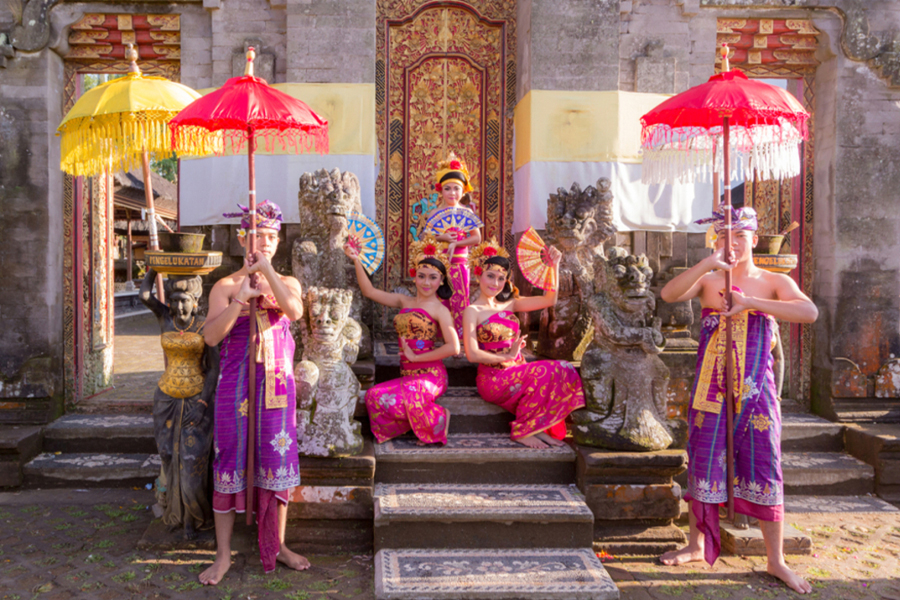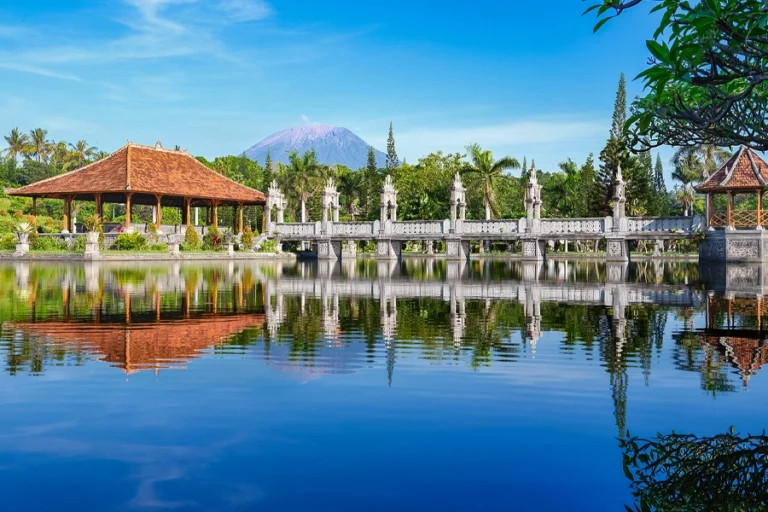Tucked away in the heart of Ubud—Bali’s cultural and artistic soul—Saraswati Temple (Pura Taman Saraswati) stands as a symbol of spiritual devotion, artistic elegance, and harmony with nature. Dedicated to Saraswati, the Hindu goddess of knowledge, wisdom, and the arts, this water temple is a serene sanctuary where culture, spirituality, and natural beauty converge.

As you approach the temple, you’re welcomed by a stunning lotus pond that stretches out before you like a mirror to the heavens. Framed by ornate stone carvings and lush greenery, the scene is as peaceful as it is picturesque. The vibrant blooms floating atop still waters and the rhythmic murmur of fountains instantly evoke a sense of calm—making this spot a favorite for both quiet reflection and striking photography.
But Saraswati Temple is more than just a visual masterpiece. It’s a living, breathing part of Balinese cultural life. Traditional dance performances often take place here in the evening, offering visitors a chance to witness firsthand the elegance and spirituality embedded in local arts.
Whether you’re a lover of architecture, a spiritual traveler, or simply someone looking to escape the crowds and find a moment of peace, Saraswati Temple offers a uniquely enriching experience. In this guide, we’ll walk you through everything you need to know—from how to get there, what to expect, to the deeper significance behind its design—so you can make the most of your visit to this enchanting Ubud landmark.
Address
Saraswati Temple, also known as Pura Taman Saraswati, is conveniently located in the cultural heart of Ubud, making it an easy stop during your exploration of the town.
Address:
Jalan Kajeng, Ubud, Gianyar Regency, Bali, Indonesia
Its central location puts it just off the main road—Jalan Raya Ubud—and within walking distance from other key landmarks such as the Ubud Palace, Ubud Art Market, and numerous cafes, galleries, and shops. Whether you’re staying in the center of Ubud or nearby, reaching the temple is simple. Most visitors can stroll over on foot or take a quick ride via scooter or taxi from their accommodation.
Getting There
Reaching Saraswati Temple is easy and convenient due to its central location in Ubud. Whether you’re exploring on foot or using transportation, there are several ways to get there:
Walking
If you’re staying in central Ubud, Saraswati Temple is likely just a short walk away. The route takes you through Ubud’s vibrant streets, lined with cafes, boutiques, and galleries. It’s an enjoyable stroll that lets you soak up the town’s unique atmosphere.
Scooter or Motorbike
Renting a scooter is one of the most popular ways to get around Ubud. The temple provides a small parking area nearby, making this a convenient option. Just be sure you’re confident riding, wear a helmet, and carry an international driving permit, as required by Indonesian law.
Taxi or Ride-Hailing Apps
Metered taxis and ride-hailing services like Grab and GoJek operate throughout Ubud. These apps offer a hassle-free and affordable option for getting to the temple, especially if you’re coming from the outskirts of town or prefer not to ride a scooter.

Entrance Fees
One of the wonderful things about visiting Saraswati Temple is that there is no official entrance fee. This makes it an accessible cultural experience for all travelers. However, here are a few helpful notes:
Donations are welcome. While entry is free, voluntary donations are appreciated. These go toward the upkeep and preservation of the temple.
Parking fees apply.
Cars: IDR 10,000
Scooters: IDR 5,000
These charges support the maintenance of parking facilities and help keep the temple grounds organized.
Best Time to Visit
Timing your visit to Saraswati Temple can significantly enhance your experience. Here are some helpful suggestions:
Early Morning or Late Afternoon
These times offer cooler temperatures and softer lighting, making them ideal for peaceful reflection and photography. Fewer visitors also mean a quieter, more serene environment to enjoy the temple’s beauty.
Weekdays Over Weekends
To avoid crowds, plan your visit on a weekday. Weekends are generally busier with both local and international tourists. A weekday visit offers a more relaxed and intimate atmosphere.
During Ceremonies and Festivals
The temple becomes especially lively during religious ceremonies and Balinese festivals. These events provide a unique opportunity to witness traditional rituals and cultural performances. However, expect larger crowds and limited access to some areas during sacred events.
Dry Season (April to October)
The best time of year to visit is during Bali’s dry season, when the weather is most pleasant. While the temple remains open year-round, visiting during the rainy season (November to March) may require extra preparation, such as bringing an umbrella or raincoat.

What to See and Do
Saraswati Temple is more than just a beautiful landmark — it’s a cultural and spiritual treasure in the heart of Ubud. Here’s what you can experience during your visit:
Lotus Pond
The temple’s most iconic feature is its stunning lotus pond. Filled with vibrant pink blossoms, it creates a peaceful and photogenic scene, especially when the flowers are in full bloom. Walking along the stone pathways beside the pond is a calming experience.
Temple Architecture
Admire the intricate stone carvings and traditional Balinese architecture throughout the temple grounds. The elaborate reliefs and statues depict scenes from Hindu mythology and reflect the exceptional artistry of Balinese craftsmen.
Pura Taman Saraswati (Main Temple Area)
Dedicated to Saraswati, the goddess of knowledge and the arts, the main temple structure stands as the spiritual heart of the complex. While access to the inner sanctum is limited to worshippers, visitors can explore the outer areas and observe the temple’s design and sacred atmosphere.
Balinese Dance Performances
In the evenings, the temple often hosts traditional Balinese dance performances. Set against the backdrop of the lotus pond and temple gates, these performances offer a captivating blend of music, movement, and storytelling.
Photography
The temple is a favorite spot for photographers. Early morning and late afternoon are the best times to capture the temple in soft, golden light. Whether you’re shooting wide landscapes or close-ups of lotus flowers and carvings, there are endless photo opportunities.
Meditation and Reflection
The tranquil setting makes Saraswati Temple an ideal place for quiet reflection. Find a shaded corner or sit by the pond to enjoy a few peaceful moments away from Ubud’s lively streets.
Cultural Exploration
Take time to learn about the temple’s significance and its role in Balinese Hinduism. You may witness locals making offerings or participating in ceremonies, giving you a deeper insight into the island’s living traditions.

Where to Stay
Ubud, the cultural heart of Bali, offers a wide range of accommodation options to suit every budget and travel style. Whether you’re seeking luxurious seclusion, boutique charm, or a budget-friendly retreat, here are some top picks near Saraswati Temple:
Mandapa, a Ritz-Carlton Reserve
A world-class resort offering exquisite private villas, serene riverside settings, and exceptional personalized service. Perfect for those seeking ultimate luxury and privacy.
Four Seasons Resort Bali at Sayan
Renowned for its dramatic architecture and lush tropical gardens, this five-star resort provides a tranquil escape with luxurious amenities and panoramic jungle views.
Bisma Eight
Combining contemporary design with natural elements, Bisma Eight offers stylish suites, an infinity pool overlooking the forest, a rooftop bar, and a farm-to-table dining experience—all within a short walk of Ubud’s attractions.
Warwick Ibah Luxury Villas & Spa
Located near the Campuhan Ridge Walk, this elegant property blends traditional Balinese architecture with modern comfort. Guests enjoy spacious villas, peaceful gardens, and an on-site spa.
Element by Westin Bali Ubud
This eco-conscious hotel emphasizes wellness and comfort, featuring saltwater pools, fitness facilities, and healthy dining options. It’s ideal for travelers looking to unwind in a calm, modern setting.
Artini 2 Cottages
A budget-friendly choice with traditional Balinese character. The cottages are simple yet cozy, surrounded by gardens and a pool, and conveniently located near Ubud’s main attractions.
The Purist Villas & Spa
Tucked away just outside the center of Ubud, this boutique resort offers luxurious villas with private pools and a focus on wellness, relaxation, and personalized service.
Adiwana Resort Jembawan
Specializing in holistic healing and wellness, this resort offers yoga classes, spa treatments, and healthy dining in a serene setting. Ideal for travelers seeking rejuvenation.
Kamandalu Ubud
Set amidst Ubud’s hills, Kamandalu combines the feel of a traditional Balinese village with modern comforts. With private pool villas, lush surroundings, and an award-winning spa, it’s a top choice for a romantic or peaceful getaway.

Nearby Attractions
Ubud is a treasure trove of cultural, natural, and artistic experiences. While visiting Saraswati Temple, take time to explore these nearby highlights to make the most of your trip:
Ubud Palace (Puri Saren Agung)
Located just a short walk from Saraswati Temple, this historic royal residence showcases classic Balinese architecture and beautifully maintained gardens. In the evenings, it becomes a vibrant cultural venue hosting traditional Balinese dance performances.
Ubud Art Market
Situated directly across from Ubud Palace, the art market is a lively destination for locally crafted goods. Browse a wide array of textiles, jewelry, paintings, wood carvings, and souvenirs. It’s the perfect spot to experience local craftsmanship and take home a piece of Bali.
Ubud Monkey Forest (Sacred Monkey Forest Sanctuary)
Home to over 700 long-tailed macaques, this shaded sanctuary is not only a haven for monkeys but also features ancient temples and moss-covered pathways. A visit here offers both natural beauty and cultural intrigue, just a short distance from central Ubud.
Campuhan Ridge Walk
This scenic walking trail winds through green hills and valleys, offering panoramic views and a peaceful escape from the town. It’s ideal for a morning or late afternoon stroll and is just a 10-minute walk from the temple.
Blanco Renaissance Museum
Dedicated to the works of Spanish painter Don Antonio Blanco, this museum combines art, history, and nature. The museum’s eclectic architecture, lush gardens, and hilltop views make it an inspiring visit for art lovers.
Tegalalang Rice Terrace
A short drive from Ubud, the Tegalalang terraces are one of Bali’s most iconic landscapes. With sweeping, tiered fields and traditional Subak irrigation, they offer great photo opportunities and a glimpse into Balinese farming traditions.
Goa Gajah (Elephant Cave)
Dating back to the 9th century, Goa Gajah is a spiritual and archaeological site featuring a carved cave entrance, meditation chambers, and bathing pools. It’s a quiet, mystical place to explore Bali’s ancient past.
Tegenungan Waterfall
Located a 20-minute drive from Ubud, this dramatic waterfall is surrounded by jungle and ideal for swimming or relaxing at its base. Accessible via a short hike, it’s a great stop for nature lovers and photographers.
Tirta Empul Temple
A sacred water temple known for its purification pools. Balinese Hindus visit Tirta Empul for ritual bathing, and visitors can participate or simply observe this powerful spiritual tradition. It’s a peaceful, moving experience surrounded by jungle and temple architecture.
History of Saraswati Temple
Saraswati Temple, also known as Pura Taman Saraswati, is a beautiful example of Balinese Hindu architecture and holds a special place in Ubud’s cultural and spiritual life. Here’s a brief look at its historical and cultural significance:
Construction and Dedication
The temple was designed by I Gusti Nyoman Lempad, one of Bali’s most revered artists and architects. It was built in the early 1950s under the patronage of Prince Cokorda Gede Agung Sukawati, who envisioned the temple as both a spiritual site and a celebration of the arts. It is dedicated to Dewi Saraswati, the Hindu goddess of wisdom, learning, and the arts.
Architectural Significance
Saraswati Temple showcases intricate stone carvings, classic Balinese gates (Candi Bentar), and lush gardens that embody the harmony between nature and spirituality. The temple’s most iconic feature is its lotus pond, flanked by walking paths and surrounded by blooming pink lotuses that reflect the goddess’s grace and beauty.
Cultural Importance
This temple is a central site for religious ceremonies, especially during Saraswati Day, which occurs every 210 days based on the Balinese Pawukon calendar. On this day, students and scholars across Bali offer prayers to Dewi Saraswati, seeking blessings for knowledge and inspiration.
Artistic Hub
True to its dedication to the goddess of art and knowledge, Saraswati Temple has become a vibrant cultural venue. It frequently hosts traditional Balinese dance performances, such as the Legong dance, which take place in the temple’s open courtyard and are often illuminated by evening lights. These performances help preserve Bali’s living cultural traditions.
Modern-Day Relevance
Today, Saraswati Temple is not only a place of worship for the local community but also a serene retreat for travelers. It remains a symbol of Balinese devotion, artistry, and spiritual life, drawing visitors who seek a deeper connection to Bali’s unique heritage.

Architecture and Design of Saraswati Temple
Saraswati Temple, or Pura Taman Saraswati, is a masterpiece of traditional Balinese architecture, intricately woven with spiritual symbolism and artistic detail. Each element of the temple’s design reflects Bali’s deep-rooted connection to Hinduism, nature, and the arts. Here’s what makes the temple’s architecture so captivating:
Entrance Gate (Candi Bentar)
The temple’s entrance is marked by a traditional Balinese split gate known as Candi Bentar. Adorned with detailed carvings, this gate serves as a symbolic threshold — a transition from the secular outer world into the sacred spiritual space within.
Lotus Pond
Perhaps the most iconic feature of Saraswati Temple is the large lotus pond that stretches before the temple. Filled with blooming pink lotuses and framed by stone walkways, the pond not only adds serene beauty but also represents purity, enlightenment, and devotion in Balinese Hindu philosophy.
Main Temple Shrine
At the heart of the complex stands the main temple structure, dedicated to Dewi Saraswati, the goddess of knowledge, wisdom, and the arts. Built on an elevated base, the shrine features ornately carved reliefs and statues that illustrate tales from Hindu epics and express reverence for the goddess.
Stone Carvings and Sculptures
The temple’s carvings are the work of I Gusti Nyoman Lempad, one of Bali’s most revered artists. These exquisite carvings showcase Hindu deities, mythical figures, and organic motifs like leaves and flowers — each rendered with exceptional craftsmanship that highlights the island’s rich artistic heritage.
Bale (Ceremonial Pavilions)
Scattered throughout the temple grounds are traditional bale, or open-air pavilions. These structures, supported by ornately carved wooden columns, serve as spaces for rituals, ceremonies, and quiet contemplation. The bales are often adorned with traditional textiles and canang sari (daily offerings).
Gardens and Pathways
Surrounding the temple are lush gardens filled with tropical plants and trees, enhancing the temple’s natural tranquility. Stone pathways and arched bridges guide visitors across the lotus pond, inviting exploration and reflection as part of the temple experience.
Padmasana Shrine
Located at the spiritual center of the complex is the Padmasana, or “lotus throne.” This vertical shrine symbolizes the seat of the Supreme God in Balinese Hinduism. Towering and richly ornamented, it acts as the focal point of worship during major ceremonies.
Inner Gates (Kori Agung)
Beyond the Candi Bentar, the temple features additional Balinese gates called Kori Agung, which separate the various inner sanctums. These elaborately decorated gateways mark transitions between sacred zones within the temple and are often reserved for ceremonial use.

Significance of Saraswati Temple
Saraswati Temple, or Pura Taman Saraswati, is more than just a beautiful landmark in the heart of Ubud. It holds deep spiritual, cultural, and communal importance for both the local Balinese people and visitors from around the world.
Spiritual Significance
The temple is dedicated to Dewi Saraswati, the Hindu goddess of knowledge, wisdom, and the arts. For Balinese Hindus, this sacred site is a place of prayer, meditation, and ceremonial worship. The iconic lotus pond at the temple’s entrance symbolizes purity and enlightenment—qualities associated with Saraswati herself—and enhances the temple’s spiritual atmosphere.
Cultural Heritage
As one of Ubud’s key cultural landmarks, the temple represents the artistic and religious heritage of Bali. Its intricate stone carvings, many created by the master artist I Gusti Nyoman Lempad, are not only visually stunning but also steeped in Balinese mythology. Every element, from the architectural details to the layout, reflects the island’s unique traditions and spiritual beliefs.
Educational Role
Saraswati Temple plays a central role during Saraswati Day, a religious festival held every 210 days in the Balinese calendar. On this day, students, teachers, and scholars visit the temple to honor the goddess and seek blessings for intellectual growth. The temple thus reinforces the Balinese value of lifelong learning and respect for knowledge.
Artistic Hub
In addition to being a place of worship, the temple serves as a center for the performing arts. Traditional dance performances, such as the graceful Legong dance, are regularly held in the temple courtyard. These events allow visitors to witness authentic Balinese culture in a sacred and aesthetically rich setting.
Tourist Attraction and Cultural Bridge
The temple is a major point of interest for tourists in Ubud, offering a chance to experience living Balinese culture firsthand. Visitors are drawn not just by its beauty, but by the opportunity to engage with local customs, observe religious rituals, and attend artistic performances. In this way, Saraswati Temple fosters cross-cultural understanding and appreciation.
Community Gathering Place
Beyond its religious importance, the temple also serves as a gathering space for the local community. Ceremonies, festivals, and social events bring people together, reinforcing bonds and maintaining cultural continuity. It is a space where tradition is celebrated and passed down through generations.
Architectural Symbolism
The temple is a striking example of Balinese architecture in harmony with nature, embodying the philosophy of Tri Hita Karana—the balance between humans, nature, and the divine. The lotus pond, temple shrines, and surrounding gardens together create a sacred and balanced environment that reflects this worldview.
Cultural Preservation
By remaining an active place of worship and a venue for traditional arts, Saraswati Temple plays a vital role in preserving Balinese customs and identity. It acts as a living link between past and present, ensuring that the island’s spiritual and cultural legacy continues to thrive.
Travel Tips for Visiting Saraswati Temple
A visit to Saraswati Temple in Ubud offers a rewarding cultural and spiritual experience. To make the most of your time at this serene site, consider the following practical and respectful travel tips:
Dress Modestly
Saraswati Temple is an active place of worship, so visitors are expected to wear modest clothing. Ensure your shoulders and knees are covered. Sarongs and sashes are usually available at the entrance if needed, and using them shows respect for local customs.
Respect the Culture
As with all temples in Bali, it’s important to maintain a respectful attitude. Keep your voice low, avoid disruptive behavior, and never climb on temple structures. If there is a ceremony in progress, observe quietly from a respectful distance. Always ask before photographing people, especially locals in traditional dress or during prayer.
Mindful Photography
The temple and its lotus pond provide beautiful photo opportunities. Early morning and late afternoon offer the best lighting. While photography is welcome, avoid using flash and refrain from taking pictures in sacred inner areas unless permitted.
Attend a Dance Performance
One of the unique features of Saraswati Temple is its evening dance performances, often held with the temple as a backdrop. These shows, including the traditional Legong dance, provide a vivid introduction to Balinese performing arts. Check performance schedules in advance to plan your visit accordingly.
Getting There and Parking
Parking around the temple can be limited, especially during busy hours. If you’re staying nearby, walking is a pleasant and practical option. Alternatively, consider using ride-hailing apps like Grab or GoJek, or local taxis for convenience.
Observe Local Etiquette
Before entering certain parts of the temple, it’s customary to remove your shoes. Women who are menstruating are traditionally advised not to enter sacred areas. Familiarizing yourself with these customs helps you navigate the temple grounds respectfully.
By keeping these tips in mind, you’ll ensure a meaningful and respectful visit to Saraswati Temple. Whether you’re there to admire its stunning architecture, learn about Balinese spirituality, or enjoy a traditional performance, these guidelines will help you make the most of your experience.





